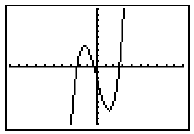Inverse Functions
Section 1.5 Inverse Functions
Objective: In this lesson you learned how to find inverses of functions
graphically and algebraically .
| Important Vocabulary Define each term or
concept. Inverse function Let f and g be two functions . If f (g (x)) = x for every x in the domain of g and g (f (x)) = x for every x in the domain of f, then g is the inverse of the function f. The function g is denoted by f -1. One-to-one A function f is one-to-one if, for a and b in its domain, f (a) = f (b) implies a = b. Horizontal Line Test A function is one-to-one if every horizontal line intersects the graph of the function at most once. |
| I. The Inverse of a Function (Pages 120-122) For a function f that is defined by a set of ordered pairs , to form the inverse function of f, . . . interchange the first and second coordinates of each of these ordered pairs. For a function f and its inverse f -1, the domain of f is equal to the range of f -1 , and the range of f is equal to the domain of f -1 . To verify that two functions , f and g, are inverses of each other, . . . find f (g (x)) and g (f (x)). If both of these compositions are equal to x for every x in the domain of the inner function, then the functions are inverses of each other. Example 1: Verify that the functions f (x) = 2x - 3 and  are inverses of each other. are inverses of each other. |
What you should learn How to find inverse functions informally and verify that two functions are inverses of each other |
| II. The Graph of an Inverse Function (Page 123) If the point (a, b) lies on the graph of f , then the point ( b , a ) lies on the graph of f -1 and vice versa. The graph of f -1 is a reflection of the graph of f in the line y = x . |
What you should learn How to verify graphically and numerically that two functions are inverses of each other |
| III. The Existence of an Inverse
Function (Page 124) A function f has an inverse f -1 if and only if . . . f is one-to-one. If a function is one-to-one, that means . . . that no two elements in the domain of the function correspond to the same element in the range of the function. To tell whether a function is one-to-one from its graph, . . . simply use the Horizontal Line Test, that is, check to see that every horizontal line intersects the graph of the function at most once. Example 2: Does the graph of the function at the right have an inverse function? Explain. No, it doesn’t pass the Horizontal Line Test . |
What you should learn How to use graphs of functions to decide whether functions have inverses |
 |
|
| IV. Finding Inverse Functions Algebraically (Pages 125-126) To find the inverse of a function f algebraically , . . . 1) Use the Horizontal Line Test to decide whether f has an inverse. 2) In the equation for f (x), replace f (x) by y. 3) Interchange the roles of x and y, and solve for y . 4) Replace y by f -1(x) in the new equation. 5) Verify that f and f -1 are inverses of each other by showing that f (f -1(x)) = x and f -1(f(x)) = x. Example 3: Find the inverse (if it exists) of f (x) = 4x - 5 . f -1(x) = 0.25x + 1.25 |
What you should learn How to find inverse functions algebraically |
| Homework Assignment Page(s) Exercises |
|
| Prev | Next |